The Joist Review window ( Modeling ) (" Status " & " Properties " enabled )
page 1 | contents | review | top
|
|||||
|
|
||||
Section Size: The joist's main material . Only materials listed in the local shape file can be specified here. If the user of a full-featured SDS2 program has entered a material other than joist material , the result is the connection failure message " Invalid material type for this member ."
Piecemark or System piecemark or User piecemark or Frozen piecemark :
Sequence :
Shape: Parallel or Single pitch or Double pitch or Arched chord or Bowstring or Scissor or Triple pitch or BIM custom .
|
|
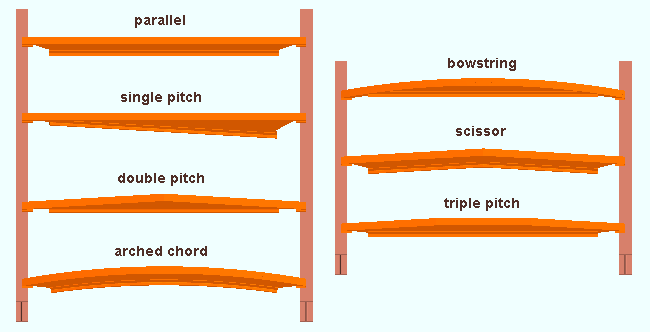
' Parallel ' makes the top and bottom chords of the joist parallel with one another.
' Single pitch ' angles the bottom chord with respect to a horizontal top chord.
' Double pitch ' divides the top chord of the joist into two sections, each of which slope to a peak at or near the joist's center. The " Peak offset " sets the distance of the peak from the left end of the joist. The bottom chord is straight.
' Arched chord ' arches both the top and bottom chords of the joist. The " Top chord radius " sets the curvature of the top cord, which in turn sets the curvature of the bottom chord so that the same distance of separation is maintained between all corresponding points along the two chords. .
' Bowstring ' arches the top chord of the joist while the bottom chord stays straight. The " Top chord radius " sets the curvature of the top cord.
' Scissor ' makes both the top chord and the bottom chord of the joist come to a peak. The " Peak offset " sets the distance of that peak from the left end of the joist.
' Triple pitch ' divides the top chord into three different sections, each with a different pitch. The center section of the top chord is parallel with the bottom chord. The bottom chord is straight. The two outside sections of the top chord slope upward toward the center sect on.
' BIM custom ' is a shape that is provided by a joist manufacturer. If a custom shape is not provided, a parallel joist shape will be generated.
Peak offset: The distance parallel with the joist's input work points (in the primary dimension " Units " or other units ) from the left end of the joist to the peak of the joist.
|

|
|
The " Peak offset " option applies when ' Double pitch ' or ' Scissor ' is selected as the " Shape ." The joist shown here is a scissor joist. The left end of the joist is identified by an origin reference point symbol ( |
For a ' Double pitch ' joist, the " Peak offset " positions the peak at the top chord. For a ' Scissor ' joist, as is shown in the example above, " Peak offset " positions the peaks at both the top and bottom chords.
Top chord radius: The distance (in the primary dimension " Units " or other units ) that any and all points on the top of the joist's top chord are from the center of a circle that circumscribes the top of the joist's top chord.
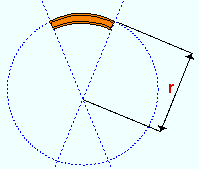
|
r = top chord radius. If you were to extrapolate a circle from the curvature of the joist's top chord, the distance from any point on that curve to the center of the circle is the distance entered here. |
The " Top chord radius " option applies when ' Arched chord ' or ' Bowstring ' is selected as the " Shape ."
Joist rotation: A positive (+) or negative (-) number of degrees.
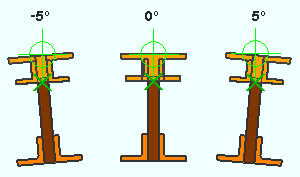
|
The axis of rotation is a line through the input points of the joist, which are marked with an X . The " Input elevation " does not change when the joist is rotated. As shown in this example, the left-end top chord reference symbol ( |
' 0 ' degrees orients the joist vertically, that is, so that it its web panel is vertical.
' A positive number ' of degrees rotates the joist clockwise from its zero position.
' A negative number ' of degrees rotates the joist counterclockwise from its zero position.
Panel display method: Automatic or Reserved or Mfg pre-config or User pre-config . The choice made here does not affect the types of connections that can be generated for a joist. It only affects the appearance of the joist, not its functionality.
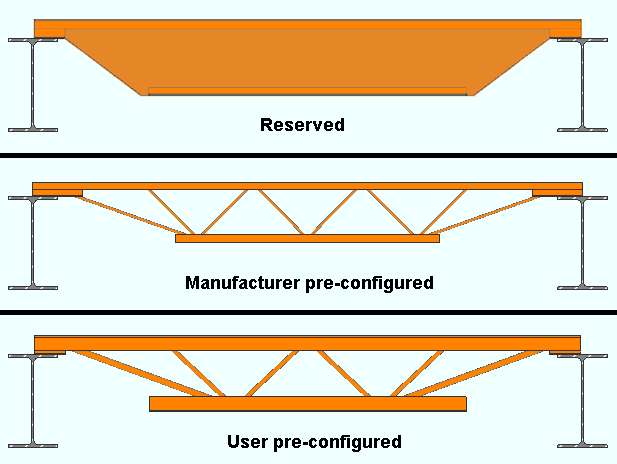
' Automatic ' applies the choice made to " Panel display method " in Joist Manufacturers ( Home > Project Settings > Job ).
' Reserved ' puts a flat plate layout as a placeholder at the approximate location where web material can be designed by a manufacturer.
' Mfg pre-config ' requires that the joist manufacturer has provided BIM information for the joist. If the manufacturer has not provided such information, the joist is displayed as if ' Reserved ' had been selected.
VIDEO 
The " Panel display method " is set to ' Mfg pre-config ', but since the manufacturer has not provided valid panel configuration, the user gets a warning. (Recorded in SDS2 Detailing , v2017.) ' User pre-config ' provides an approximation of the joist panel. " User preconfigured panel " options on this window are applied to the joist.
VIDEO 
The " Panel display method " is set to ' User configured panel ' and settings under " User preconfigured panel " are adjusted. The result is shown in the model. (Recorded in SDS2 Detailing , v2017.)
------------------
Main material : ![]() or
or ![]() .
.
Marked for processing : ![]() or
or ![]() .
.
Marked for detailing : ![]() or
or ![]() . This "
. This " ![]() General settings " button reads
General settings " button reads ![]() by default since joists cannot be detailed.
by default since joists cannot be detailed.
Node-match job : ![]() or
or ![]() .
.
Model complete : ![]() or
or ![]() .
.
Model complete date : **NOT SET** or a month day year .
------------------
WP to WP length, plan: The work point-to-work point distance spanned by the joist workline in a plan view, ignoring elevation.
This "
General settings " distance is calculated from the X and Y (but not Z) global coordinates of the joist work points. If the joist is sloped out of the plan view elevation, the value show here is not the actual work point-to-work point length, but rather the distance from grid line to grid line as measured at a single elevation.
WP to WP length, actual: The actual length of the joist workline.
This "
General settings " distance is calculated from the X and Y and Z global coordinates of the joist work points. Subtracting the joist's " Setbacks " from this distance gives you the actual length of the joist.
Lift assignment : not assigned or a crane placement name .
Bay pitch: This " ![]() General settings " information reports the rise/run of the joist. The pitch is calculated by taking the difference between the joist's left- and right-end " Top of joist " elevation then dividing that difference by the " WP to WP length, actual ." If your current project's setup units are imperial " Units ," the " Bay pitch " is reported in in/ft. For metric " Units ," the " Bay pitch " it is reported in mm/250 mm.
General settings " information reports the rise/run of the joist. The pitch is calculated by taking the difference between the joist's left- and right-end " Top of joist " elevation then dividing that difference by the " WP to WP length, actual ." If your current project's setup units are imperial " Units ," the " Bay pitch " is reported in in/ft. For metric " Units ," the " Bay pitch " it is reported in mm/250 mm.
|
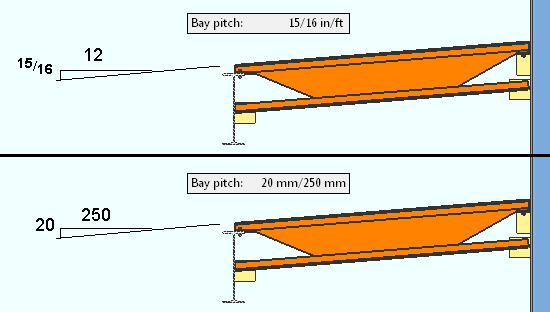
If the left-end " Top of joist " elevation is greater than the right-end " Top of joist ," the " Bay pitch " is a negative number.
If the left- and right-end " Input " elevation are both the same, the " Bay pitch " is ' 0 '.
If the left-end " Top of joist " elevation is less than the right-end " Top of joist ," the " Bay pitch " is a positive number.
page 1 | contents | review | top
|
|||||
|
|
||||
Panel layout: ![]() Automatic or
Automatic or ![]() Panel width or
Panel width or ![]() Number of panels or
Number of panels or ![]() Panel point spacing. This "
Panel point spacing. This " ![]() User preconfigured panel " option applies when the joist's " Panel display method " is ' User pre-config'. It can also apply when the " Panel display method " is ' Automatic '.
User preconfigured panel " option applies when the joist's " Panel display method " is ' User pre-config'. It can also apply when the " Panel display method " is ' Automatic '.
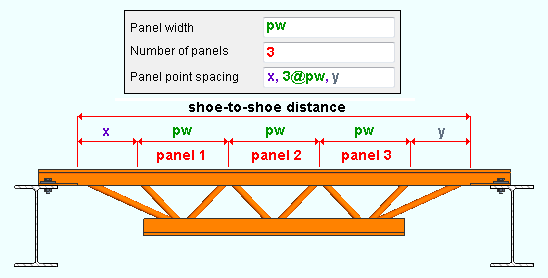
'
Automatic ' attempts to use the depth of the " Section size " as the panel width.
'
Panel width' indicates that a user of a full-featured SDS2 program has entered the panel width, which results in the ' Number of panels ' and ' Panel spacing ' being automatically calculated to fill the available space.
'
Number of panels' indicates that a user of a full-featured SDS2 program has entered the number of panels, which results in the ' Width ' and ' Panel spacing ' being automatically calculated to fill the available space.
'
Panel point spacing ' indicates that a user of a full-featured SDS2 program has entered the spacing between panel points, which results in the ' Number of panels ' and ' Panel width '
Panel member material: Automatic or Angle or Channel or Round bar. This " ![]() User preconfigured pane " option applies when the joist's " Panel display method " is ' User pre-config'.
User preconfigured pane " option applies when the joist's " Panel display method " is ' User pre-config'.
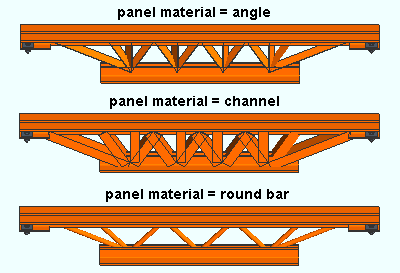
' Automatic ' looks at the joist type (K, KCS, LH, DLH, etc.) as described in this joist's " Section size ." It then looks to Joist Manufacturers ( Home > Project Settings > Job ) to determine what material to use for that joist type.
' Angle' sets the diagonals in the joist panel to be angle material. The " Configuration " can be set to ' Automatic ' or ' Crimped single angle ' or ' Double angle '.
'Channel' sets the diagonals in the joist panel to be channel material. The " Panel section size " is, by default, the smallest available channel section size (e.g., MC3x7.1).
' Round bar' sets the diagonals in the joist panel to be round bar material. The " Configuration " can be set to ' Auto filler thickness ' or ' User rod '.
Configuration: Available choices depend on whether the " Panel member material " is ' Angle' or ' Round bar '.
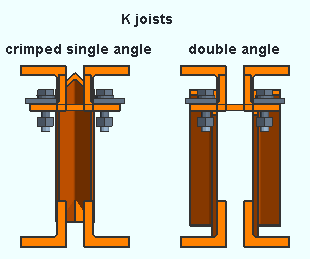
|
' Automatic ' or ' Crimped single angle ' or ' Double angle ' apply when the " Panel member material " is ' Angle'. |
' Automatic ' reads the configuration specifed in Joist Manufacturers ( Home > Project Settings > Job ).
' Crimped single angle ' specifies that each panel member is a single angle whose " Panel section size " is as specified below. This is a configuration commonly used in joist manufacturing. The angle centroids are oriented to prevent eccentricities and provide uniform distribution of loads. The crimped portion of the angles fit between the top or bottom chord materials.
' Double angle ' specifies that each diagonal in the joist consist of a NS angle and FS angle, with each such angle welded to the NS or FS top and bottom chord materials. Each angle is the " Panel section size " that is specified below.
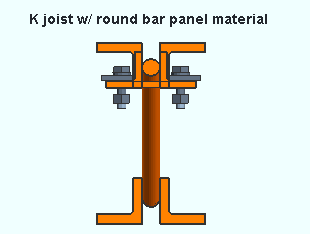
|
' Auto filler thickness ' or ' User rod ' apply when the " Panel member material " is ' Round bar '. |
' Auto filler thickness ' lets the joist program determine the diameter of the round bar panel materials using the filler thickness assigned to the joist " Section size " in the local shape file.
' User rod ' indicates that the user of a full-featured SDS2 program .has specified the " Panel section size " to be used for the round bar panel materials.
Panel section size: An angle section size or a round bar section size or a channel section size .
An ' angle section size ' applies when the " Panel member material " is an ' Angle '.
A ' round bar section size ' applies when the " Panel member material " is a ' Round bar '.
A ' channel section size ' applies when the " Panel member material " is a ' Channel '.
page 1 | contents | review | top
|
|
| Determining a member's left end : |
| Look at the location of its piecemark (B_2). |
| Look at its reference point ( |
| The left end is related to global coordinates . |
| Left end of a member in a plan view . |
| Left end of members in an elevation view . |
indicates that, in a full-featured SDS2 program , all options are disabled ( grayed out ) under [ Left end settings ] or [ Right end settings ] , thus preventing users from making changes to the end connection. To preserve the connection, users of that program are also prevented from manually editing or cutting or deleting connection materials on the locked end of the member.
indicates that a user of a full-featured SDS2 program is allowed to edit the options under [ Left end settings ] or [ Right end settings ] .
Status Display: Approval and modeling > Member end locked
page 1 | contents | review | top
|
|
|||||||||
|
|
||||||||
Connection: Force and/or Graphical or a System connection .
' Force ' indicates a failed connection has been forced to be designed in a full-featured SDS2 program , even though the design may be ill advised from an engineering standpoint.


forced 

system The Connection Design Calculations report (and Expanded Connection Design Calculations ) include a warning that the connection has been forced.
' Graphical ' indicates that the connection on this end of the member is graphical and, therefore, will not be changed during connection design in a full-featured SDS2 program .


graphical 

system The Connection Design Calculations report (and Expanded Connection Design Calculations ) include the warning " GRAPHICAL CONNECTION -- STRENGTH CALCULATIONS NOT GENERATED ."
Status Display: Search > Graphical connections
Search: Graphical Connections
" Connection design locks set ," connection failure messages , other messages:
The following banner notifies you that the connection has at least one " Connection design lock " setting that is locked (
):
Connection design locks set.
VIDEO 
Sections (" leaves ") within which at least one locked variable resides are marked (in the navigation tree) with a locked icon ( ). (Recorded in SDS2 Detailing , v2015.)
Search: Connection design locks set
Status Display: Search > Connection design locks setYou may find a red connection failure banner like that shown below along with a
button. The button doesn't do anything in SDS2 Site Planning. In a full-featured SDS2 program, the button provides context-sensitive help about the message.
| Beam flange too narrow for joist bearing |
If you are reviewing multiple joists and those joists have different connection failure messages, you get a banner like the following:
| Multiple connection messages |
page 1 | contents | review | top
|
|
|||||||||
|
|
||||||||
See the topic " Determining left end & near side " if you are unsure which end of this joist is the left end and which is the right end.
Top of joist: ![]() Automatic or
Automatic or ![]() Elevation or
Elevation or ![]() Elevation @ extension end .
Elevation @ extension end .
|
'
Automatic ' lets the joist program automatically adjust the elevation of the top chord to -- for the general case -- be the " Input elevation " plus the depth of the " Bearing shoe ." When '
Automatic ' is selected, the read-only value that is reported for " Elevation " is this automatically calculated elevation.
'
Elevation ' lets you enter the left- or right-end top chord top elevation (a distance in the primary dimension " Units " or other units ). Changing this elevation moves the left- or right-end of the joist up or down. The top of joist elevation is in vertical alignment with the input point.
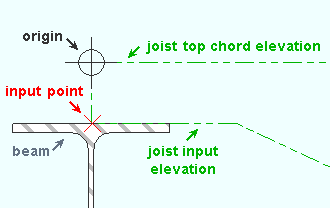
A joist in stick form with the " Joist outline " option in Display Options turned on (checked). The origin symbol (
) of the joist is at the " Top of joist " elevation of the left end of the joist.
To determine the joist top chord elevation in the 3D model, use Construction Line Add or a similar tool, select EXPT as the Locate option, then snap the point location target to the top chord at either end of the joist. The Z coordinate reported in the X-Y-Z display tells you the elevation at the snapped-to exact point.
'
Elevation @ extension end ' may be the choice that you want to select when the joist is sloping and its top chord has been extended. You can then enter the elevation at that extension end (a distance in the primary dimension " Units " or other units ).
VIDEO 
A sloping joist is added in a full-featured SDS2 program. For " Top chord ," a ' Chord only (S type) extension ' is added and the ' Elevation @ extension end ' is adjusted for " Top of joist ." (Recorded in SDS2 Detailing , v2017.)
Supporting chord: Top or Bottom .
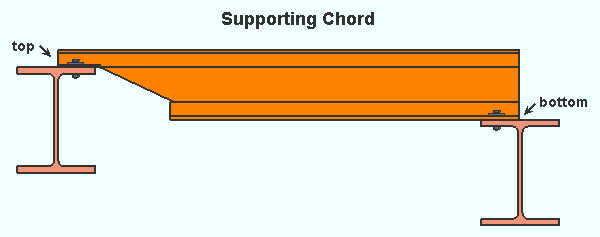
' Top ' specifies that it is the joist's top chord should connect to the supporting member at the " Input elevation " of the relevant end. In the industry, this is referred to as the "underslung end'.
' Bottom ' specifies that it is the joist's bottom chord should connect to the supporting member at the " Input elevation " of the relevant end. In the industry, this is referred to as the "square end."
Bearing shoe: ![]() Automatic or
Automatic or ![]() Depth or
Depth or ![]() Elevation .
Elevation .
|
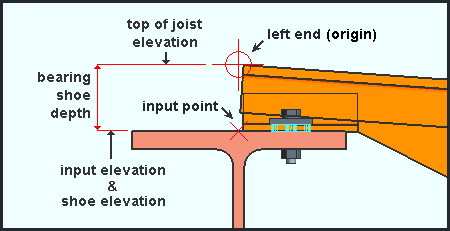
|
For a joist bearing connection, the input elevation and shoe elevation are the same, and therefore the fields that report those elevations are marked as linked.( |
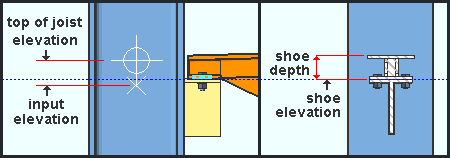
|
For a joist seat, the input elevation and the shoe elevation are different, and therefore the fields that report those elevations are marked as unlinked ( |
'
Automatic ' sets the bearing shoe depth to be the shoe depth that is specified in the local shape file for the " Section size " that is selected. The joist program may adjust the shoe depth to prevent top chord infringement.
'
Depth' reports the ' Minimum bearing depth ' that is required. This requirement will match the shoe depth specified in the local shape file if the joist does not slope. However, if the joist slopes, you will need to set " Bearing shoe " to '
Depth ' and enter a depth that is greater than or equal to the minimum if you want a connection. See the connection failure message " Joist shoe depth is less than required minimum ."
'
Elevation' is, for the general situation of a joist bolted to a beam's top flange, linked to the " Input elevation " This means that if the user of a full-featured SDS2 program changes that " Input elevation ," this shoe elevation will also change. When the two elevations are linked, a linked icon (
) is shown. When the linked icon has been replaced with a not linked icon (
), a user of a full-featured SDS2 program can edit this setting (bearing shoe " Elevation ") and the " Input elevation " separately. The two elevations are different -- not linked -- when the joist end has a seated connection.
Input elevation: The left- or right-end bearing elevation (a distance in the primary dimension " Units " or other units ). This is the elevation that is used for connection design . Consequently, if this elevation is not correct, the connection may fail.

|
This example shows a joist in stick form with the " |
To determine the input elevation on a Joist in the 3D model, use Construction Line Add or a similar tool, select EXPT as the Locate option, then snap the point location target to the X that is shown at the end of the joist. The Z coordinate reported in the X-Y-Z display tells you the elevation at the snapped-to exact point.
Note: The input point is marked with an X at both the left and right end of a joist. That point is an exact point ( EXPT ). This applies regardless of whether the joist is displayed in stick form, or in one of the three solid forms .
page 1 | contents | review | top
|
|
|||||||||
|
|
||||||||
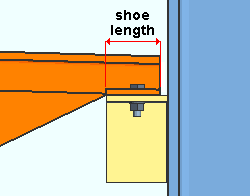
|
In this example, the " Shoe length " on the right end of the joist is set to " |
In a full-featured SDS2 program . . .
'
Auto (checked) ' sets the shoe length, when possible, to be the shoe length that is specified in the local shape file for the " Section size " that is selected and reports that length as read-only ( grayed out ). The joist program may calculate a shorter shoe length if the joist bolts to a narrow flange or a narrow seat.
'
Auto (not checked) ' lets you enter a shoe length in the primary dimension " Units " or other units .
Shoe pitch ( in/ft or mm/250mm ): ![]() Auto or
Auto or ![]() Auto . If the current Fabricator Setup " Units " are ' Imperial ', the " Shoe pitch " is reported in in/ft . For ' Metric ' units, the " Shoe pitch " is reported in mm/250 mm . Pitch can be positive (+) or negative (-).
Auto . If the current Fabricator Setup " Units " are ' Imperial ', the " Shoe pitch " is reported in in/ft . For ' Metric ' units, the " Shoe pitch " is reported in mm/250 mm . Pitch can be positive (+) or negative (-).
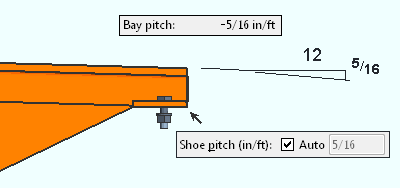
|
In this example, the " Shoe pitch " and " Bay pitch " have the same magnitude, but opposite signs. |
In a full-featured SDS2 program . . .
'
Auto (checked) ' automatically calculates the shoe pitch so that the shoe is flat to the supporting beam or seat. The calculated auto length is reported as read-only ( grayed out ).
'
Auto (not checked) ' lets you enter a positive or negative (-) pitch in in/ft (imperial) or mm/250 mm (metric).
Top chord pitch ( in/ft or mm/250mm ): ![]() Auto or
Auto or ![]() Auto . This "
Auto . This " ![]() Profile " option applies when the joist " Shape " is ' Double pitch ' or ' Scissor ' or ' Triple pitch '. If the current Fabricator Setup " Units " are ' Imperial ', the " Top chord pitch " is reported in in/ft . For ' Metric ' units, the " Top chord pitch " it is reported in mm/250 mm . Pitch can be positive (+) or negative (-).
Profile " option applies when the joist " Shape " is ' Double pitch ' or ' Scissor ' or ' Triple pitch '. If the current Fabricator Setup " Units " are ' Imperial ', the " Top chord pitch " is reported in in/ft . For ' Metric ' units, the " Top chord pitch " it is reported in mm/250 mm . Pitch can be positive (+) or negative (-).
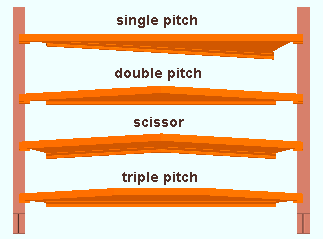
|
On a triple pitch joist, a different " Top chord pitch " can be entered for the left end and the right end. When different pitches are entered, the center section of the joist is sloped. |
In a full-featured SDS2 program . . .
'
Auto (checked )' instructs the joist program to automatically calculate the top chord pitch.
'
Auto (not checked) ' lets you enter a pitch in in/ft (imperial) or mm/250 mm (metric). For a ' Double pitch ' or ' Scissor ' or ' Single pitch ', the value you enter as the " Top chord pitch " for the left end automatically causes the " Top chord pitch " for the right end to be recalculated. If the " Peak offset " is set to "
Auto " for a ' Double pitch ' or ' Scissor ' (causing the peak to be centered), then the left- and right-end " Top chord pitch " are the same.
Bottom chord pitch ( in/ft or mm/250mm ): ![]() Auto or
Auto or ![]() Auto .
Auto .

In a full-featured SDS2 program . . .
'
Auto (checked) ' instructs the joist program to automatically calculate the bottom chord pitch. By default, when both the left- and right-end " Bottom chord pitch " are set to "
Auto " and " Peak offset " is set to "
Auto ," the bottom chord pitches will exactly match the left-end " Top chord pitch ."
'
Auto (not checked) ' lets you enter a left-end " Bottom chord pitch " in in/ft (' Imperial ') or mm/250 mm (' Metric '). The right-end " Bottom chord pitch " is automatically calculated.
Triple pitch peak offset: ![]() Auto or
Auto or ![]() Auto . This "
Auto . This " ![]() Profile " option applies when the joist's " Shape " is ' Triple pitch '
Profile " option applies when the joist's " Shape " is ' Triple pitch '

In a full-featured SDS2 program . . .
'
Auto (checked) ' instructs the joist program to automatically calculate the triple pitch peak offset. Allowing both the left- and right-end " Triple pitch offset " to be auto calculated creates a symmetrical joist that is divided into three sections approximately equal in length, with the middle section sloping parallel to the member line of the joist.
'
Auto (checked) ' lets you enter a triple pitch peak offset in the primary dimension " Units " or other units . As long as you keep the left- and right-end " Triple pitch offset " the same, the center section of the joist is parallel with the member line of the joist.
page 1 | contents | review | top
|
|
|||||||||
|
|
||||||||
Input connection type: Auto standard or User defined or Plain end or Bearing or Seated .
|
|
' Auto standard ' designs the connection on this end of the joist based on the joist's framing condition . Auto standard connections have a number of advantages .
If ' User defined ' is selected, the user defined connection file name must be entered to " User defined connection ."
' Plain end ' results in a system connection not being designed on this end of the joist.
' Bearing ' can apply to a joist bearing on a beam flange or column cap plate. For a joist bearing on steel, the connection can be ' Bolted ' or ' Welded ' per " Chord-to-support " in "
Connection specifications s." " Bearing " can also apply to a joist framing to a concrete wall. For a joist to concrete, a pocket for the joist top chord is created in the concrete. A "
Joist End Pocket " leaf contains locks that control the construction of the joist pocket. A " Schedule entry " may have created an embed to support the joist top chord.
' Seated ' is the selection to make in order to get a top chord seated connection to a column web or flange. ' Plate ' or ' Unstiffened L ' or ' Stiffened L ' or ' Tee ' may then be selected as the " Top chord seated ."
"
Connection specifications " and "
Connection design locks " provide additional options for defining the connection.
The " Design Calc " or " Expanded Calc " buttons give you the connection's design calculations.
User defined connection: The file name of the user defined connection in your current Job for this end of the joist.
This "
Connection type " option this joist end's " Input connection type " is ' User defined '.
System designed connection: The type of connection that connection design has designed on this end of the joist (e.g. ' Welded Joist ' or ' Bolted Joist ' or ' Seat ').. If a connection has failed , resulting in no solids model being created, the connection type that connection design attempted to design will still be reported here.
The "System designed connection " may be different than the " Input connection type " for the following situations:
If ' User defined ' is the selected " Input connection type ," the specific designed connection type is reported here. Press the " Design Calc " or " Expanded Calc " button for more information about that connection.
If ' Bearing ' is the selected " Input connection type " and ' Bolted ' or ' Welded ' is selected for " Chord-to-support ," the " System designed connection " may be reported to be ' Welded Joist ' or ' Bolted Joist '.
If ' Seated ' is the selected " Input connection type " for a joist to a column cap plate, connection design changes the connection type and emits (under Information ) the following connection changed message. The " System designed connection " is reported to be ' Bolted Joist '.
Conn changed. Possibly: Seated vs Plain end
NM bolt type: Auto or A325N or A325SC or A325X , etc. NM stands for "non-moment."
When " Auto " is checked (
), connection design creates the connection using the Home > Project Settings > Job > Bolts, Washers, and Holes > Bolt Settings > " Bolt type " per joist type (" K joist " or etc.) that is type appropriate for the " Section size " entered on this window.
If " Auto " is not checked (
), the non-moment bolt diameter that is shown here was entered by the user of a full-featured SDS2 program .
NM bolt diameter: Auto or a user-entered diameter .
| diameter |
|
If " Auto " is checked (
), connection design creates the connection using the Home > Project Settings > Job > Bolts, Washers, and Holes > Bolt Settings > " Bolt diameter " per joist type (" K joist " or etc.) that is type appropriate for the " Section size " entered on this window.
If " Auto " is not checked (
), the diameter that is shown in this field was entered by the user of a full-featured SDS2 program .
Use miscellaneous plates list: ![]() or
or ![]() .
.
If this box is checked (
), connection design in a full-featured SDS2 program looks to Home > Project Settings > Fabricator > Standard Fabricator Connections > Plates to determine the plate thicknesses to be used for plate seats , stiffeners for angle seats . First connection design determines the thickness of the plate required to stand up to the load, then it chooses a plate from the list that is the calculated required thickness or the next thicker. If the plate from the list results in material interferences or too narrow a clearance, connection design fails the connection and gives you the failure message, " Suitable plate thickness not found ."
If the box is not checked (
), connection design rounds the calculated required thickness of plates as based on the load to the next 1/16 inch (or 1/8 inch if the calculated required thickness is greater than 5/16 inch).
Exception: Bottom chord extension plates are the thickness specified in setup.
Disable framing situation checks: ![]() or
or ![]() . The choice made here does not affect this program. Framing situation checks are not done in SDS2 Site Planning.
. The choice made here does not affect this program. Framing situation checks are not done in SDS2 Site Planning.
If this box is checked (
), framing situation checks are turned off.
If the box is not checked (
), the framing situation checks are turned on.
page 1 | contents | review | top
|
|
|||||||||
|
|
||||||||
|
Different " |
Chord to support: Bolted or Welded . This " ![]() Connection specifications " option applies to a joist's top chord or bottom chord bearing on a beam's top flange when ' Bearing ' has been entered to " Input connection type ."
Connection specifications " option applies to a joist's top chord or bottom chord bearing on a beam's top flange when ' Bearing ' has been entered to " Input connection type ."
' Bolted '
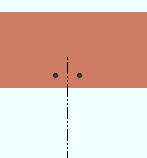
|
' Welded '
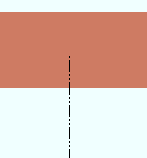
|
In a full-featured SDS2 program . . .
' Bolted ' instructs connection design to add holes and bolts to the beam flange for bolting the joist to the flange. The holes are included on the beam's member detail. The bolts can be included on Field Bolt reports and, optionally, on the beam's bill of material. The " Input elevation " of the joist must be the elevation of the beam's top flange in order for holes to be generated. The distance between the two holes is the " Top chord gage " entered in the local shape file . The choice made to " Wide flange beams, alternative gage for joist connections " or " Channel beams, alternative gage for joist connections " in Home > Project Settings > Fabricator > Standard Fabricator Connections > Joist Connection Settings set the placement of the holes with respect to the center of the beam web. Hole size is set using the " NM bolt diameter " in the "
Connection type " leaf on this window.
' Welded ' sets the joist to be field welded. A 3D field weld is not generated. The design calculations note, " Joist end welded to supporting member ."
Top chord seated material: Plate or Unstiffened L or Stiffened L or Tee . This " ![]() Connection specifications " option applies when ' Seated ' has been entered as the " Input connection type ."
Connection specifications " option applies when ' Seated ' has been entered as the " Input connection type ."
' Plate '

|
' Unstiff L '

|
' Stiffened L '

|
' Tee '

|
In a full-featured SDS2 program . . .
The joist seat that is designed is detailed on (attached to) the wide flange or tube column that the joist frames to. Joist seats are not designed on pipe columns. If L (angle) or tee seats are to be designed, there must be angle or tee material entered in Fabricator Setup > Standard Fabricator Connections > Preferred Angle Sizes or Preferred WT Sizes . If no angle or W tee material has been entered (or if an appropriate size is not listed), the program defaults to plate material for the seat.
Seat to supporting member: Automatic or Bolted or Welded . This " ![]() Connection specifications " option applies when ' Unstiffened L ' or ' Stiffened L ' has been selected as the " Top chord seated material ."
Connection specifications " option applies when ' Unstiffened L ' or ' Stiffened L ' has been selected as the " Top chord seated material ."
' Bolted '
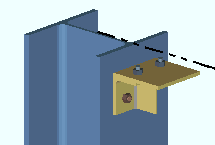 |
' Welded '
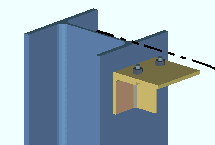
|
In a full-featured SDS2 program . . .
' Automatic ' specifies that connection design apply the choice made to Home > Project Settings > Fabricator > Standard Fabricator Connections > Joist Connection Settings > " Angle seat to supporting member ."
' Bolted ' instructs connection design to shop bolt the angle seat to the supporting column and field bolt the supported joist to the seat. The seat is a submaterial of the column and is drawn on the column detail.
' Welded ' instructs connection design to shop weld the angle seat to the column and field bolt the joist to the seat. The seat is a submaterial of the column and is drawn on the column detail.
Allow washers on bearing shoe slots: Automatic or Yes or No . This " ![]() Connection specifications " option applies to a joist's top chord or bottom chord shoe slots when ' Bearing ' or ' Seated ' has been entered to " Input connection type ."
Connection specifications " option applies to a joist's top chord or bottom chord shoe slots when ' Bearing ' or ' Seated ' has been entered to " Input connection type ."
' Yes '
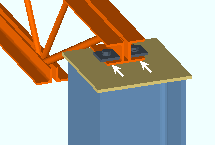 |
' No '
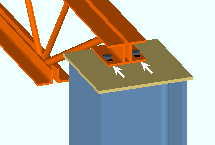
|
In a full-featured SDS2 program . . .
' Automatic ' specifies that connection design apply the choice made to Home > Project Settings > Fabricator > Standard Fabricator Connections > Joist Connection Settings > " Allow washers on bearing shoe slots ."
' Yes ' instructs connection design to add material plate washers on bearing shoe slots for bolted joist bearing and seated connections.
' No ' instructs connection design not to add material plate washers on shoe slots.
Extend bottom chord: ![]() or
or ![]() . This "
. This " ![]() Connection specifications " option and the related options " Stabilizing material " and " Use erection hole " and " Vertical stabilizer angle " are available when the joist end's " Input connection type " is ' Seated ' or ' Bearing '. " Extend bottom chord " and its related options are also available at Home > Project Settings > Job > Auto Standard Connections and at Home > Project Settings > Job > User Defined Connections .
Connection specifications " option and the related options " Stabilizing material " and " Use erection hole " and " Vertical stabilizer angle " are available when the joist end's " Input connection type " is ' Seated ' or ' Bearing '. " Extend bottom chord " and its related options are also available at Home > Project Settings > Job > Auto Standard Connections and at Home > Project Settings > Job > User Defined Connections .
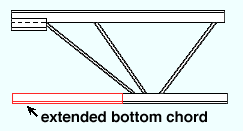
In a full-featured SDS2 program . . .
If this box is checked (
), the bottom chord of the joist is extended and " Bottom chord " is, by default, set to '
Auto ' so that the appropriate field clearance is applied. " Stabilizing material " may or may not be applied.
If the box is not checked (
), users of that full-featured SDS2 program can still apply a " Bottom chord " setback to get a bottom chord. However, those users cannot apply " Stabilizing material ."
Stabilizing material: None or Angle or Plate . The plate/angle shop welds to the supporting member and field welds to the supported joist. 3D field weld is not generated. Only the shop weld to the column is shown in the model. Connection design changes the connection material from ' Angle ' to a ' Plate ' when the bottom chord extension connects to a pipe column.
' Angle '
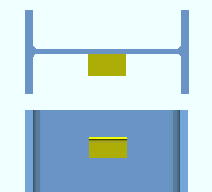
|
' Plate '
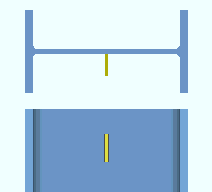
|
In a full-featured SDS2 program . . .
' None ' results in no joist bottom chord stabilizing material being created by connection design.
' Angle ' instructs connection design to use the Home > Project Settings > Fabricator > Standard Fabricator Connections > " Bottom chord extension seat angle " as the angle seat for the extended bottom chord.
' Plate ' instructs connection design to use the Home > Project Settings > Fabricator > Standard Fabricator Connections > " Bottom chord extension plate " as the stabilizing material for the extended bottom chord. Per the OSHA standard, the plate includes a 13/16 inch (21 mm) hole for guying or plumbing cables. The hole is placed 1 1/2 inch from the bottom edge and joist edge of the plate.
Use erection hole: Automatic or Yes or No . This "
Connection specifications " option applies when "
Extend bottom chord " is checked and the " Stabilizing material " is ' Plate '.
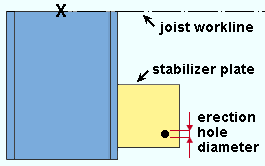
|
" Use erection hole " sets whether or not a bottom chord stabilizer plate has an erection hole. |
In a full-featured SDS2 program . . .
' Automatic ' instructs connection design to use the entry (' Yes ' or ' No ') that is made to the relevant cell at Home > Project Settings > Fabricator > Standard Fabricator Connections > Joist Connection Settings > " Use erection hole " on the " Joist type specific settings " table. That setup table can configure an erection hole to be used or not used on a per-joist-type basis.
' Yes ' instructs connection design to add a hole for guying or plumbing cables to the bottom chord stabilizer plate. Per OSHA, the hole is placed 1 1/2 inch from the bottom edge and joist edge of the plate. A connection design lock for specifying the " Erection hole diameter " is made available in the "
Joist Stabilizer Plate " leaf.
' No ' instructs connection design to not add an erection hole.
Vertical stabilizer angle:
or
. This "
Connection specifications " option applies when "
Extend bottom chord " is checked and ' Angle ' is selected as the " Stabilizing material ."
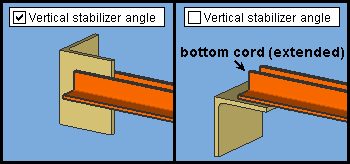
Regardless of the choice made here, the stabilizer angle shop welds to the supporting member.
In a full-featured SDS2 program . . .
If this box is checked (
), the bottom chord stabilizer angle is oriented with both legs vertical. That angle is vertically centered with respect to the bottom of the joist bottom chord.
If the box is not checked (
), the stabilizer angle is oriented so that one leg is horizontal so that it can support the joist bottom chord.
( This documentation also applies to auto standard and user defined connections. )
|
Schedule entry: A standard piecemark name from the " Piecemark " column in the Embed Schedule . An embed or bearing embed is not a designed connection, but is a separate custom member. Settings for that member do not appear in a leaf on this window. The top chord " Schedule entry " and its related options are available at Home > Project Settings > Job > Auto Standard Connections and at Home > Project Settings > Job > User Defined Connections as well as under "
Connection specifications " on the Joist Review window.
In a full-featured SDS2 program . . .
A " Schedule entry " can apply when the " Input connection type " is ' Seated ' and the joist frames to a concrete wall or tilt-up panel.
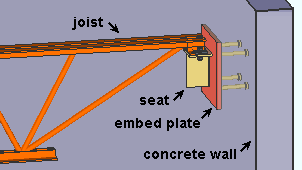
To get a top chord joist seat that welds to a custom member embed plate like the one shown here, you can select ' Seated ' as the " Input connection type ," then make a top chord embed " Schedule entry ." It is also required that the end of the joist frame to a concrete wall or a tilt-up panel.
In a full-featured SDS2 program . . .
A " Schedule entry " can also apply when the " Input connection type " is ' Bearing ' and the joist frames to a concrete wall or titl-up panel.
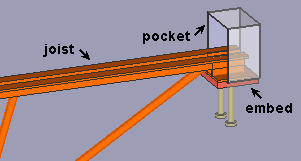
Bearing embeds can be plates or angles or channels.This example shows a plate. The " Pocket grout thickness " in this example is ' 0 ' (zero), a value which places the embed flush with the bottom of the shoe.
Connection design locks: "
Joist End Pocket "
Location: Automatic or Inside wall or Outside wall . This option applies when a top chord " Schedule entry " has been entered (above). The top chord " Location " and its related options are available at Home > Project Settings > Job > Auto Standard Connections and at Home > Project Settings > Job > User Defined Connections as well as under "
Connection specifications " on the Joist Review window.
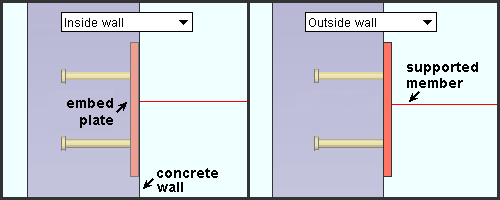
In a full-featured SDS2 program . . .
' Automatic ' specifies the automatic application of a setup choice ( Concrete Setup > Embed Schedule > " Plate location "). That setup choice sets whether the plate is located inside the concrete wall or flush to the surface of the wall.
' Inside wall ' embeds the plate in the concrete wall or tilt-up panel
' Outside wall ' locates the plate flush to the wall or panel.
( This documentation also applies to auto standard and user defined connections. )
|
Schedule entry: A standard piecemark name from the " Piecemark " column in the Embed Schedule . This option applies when "
Extend bottom chord " is checked and ' Plate ' or ' Angle ' is selected as the " Stabilizing material ." The bottom choird " Schedule entry " and its related options are available at Home > Project Settings > Job > Auto Standard Connections and at Home > Project Settings > Job > User Defined Connections as well as under "
Connection specifications " on the Joist Review window.
In a full-featured SDS2 program . . .
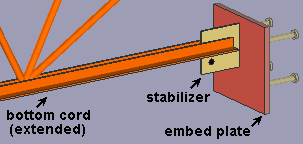
To get a bottom stabilizer that welds to a custom member embed plate like the one shown here, it is also required that the end of the joist frame to a concrete wall or a tilt-up panel.
Location: Automatic or Inside wall or Outside wall . This option applies to the bottom chord " Schedule entry " that is entered (above). The bottom chord " Location " and its related options are available at Home > Project Settings > Job > Auto Standard Connections and at Home > Project Settings > Job > User Defined Connections as well as under "
Connection specifications " on the Joist Review window.

What is referred to as the "supported member" in this example would be the extended bottom chord of the joist. Note that the embed plate is a custom member, not a part of the joist.
In a full-featured SDS2 program . . .
' Automatic ' specifies that connection design apply a setup choice ( Concrete Setup > Embed Schedule > " Plate location "). That setup choice sets whether the plate is located inside the concrete wall or flush to the surface of the wall.
' Inside wall ' embeds the plate in the concrete wall or tilt-up panel.
' Outside wall ' locates the plate flush to the wall or panel.
page 1 | contents | review | top
|
|
|||||||||
|
|
||||||||
Top chord: ' ![]() Auto or
Auto or ![]() Chord only (S type) extension or
Chord only (S type) extension or ![]() Full (R type) extension or
Full (R type) extension or ![]() Field clearance or
Field clearance or ![]() Setback . All of these dimensions require the entry of a positive distance from the input point. All except '
Setback . All of these dimensions require the entry of a positive distance from the input point. All except ' ![]() Field clearance ' are horizontal dimensionst. '
Field clearance ' are horizontal dimensionst. ' ![]() Field clearance ' is measured parallel with the slope of the joist.
Field clearance ' is measured parallel with the slope of the joist.
|
'
Auto ' indicates that the program has been instructed to automatically apply a field clearance. The "
Auto " field clearance for non auto standard connections is the " Joist to beam " or " Seats " field clearance that is entered to the Field Clearances window at Home > Project Settings > Job . Turning auto off ("
Auto " ) lets a user in a full-featured SDS2 program enter a different field clearance or change " Top chord " to ' Chord only (S type) extension ' or etc.
'
Chord only (S type) extension ' can be selected for " Top chord " when "
Auto " is off (not checked). It is the horizontal distance (in the primary dimension " Units " or other units ) from the input point ( X ) of the joist to the end of the extension.
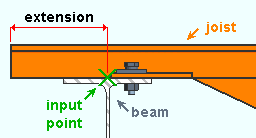
Even if the joist slopes, this dimension is measured horizontally. A " Shoe " extension can optionally be applied to a ' Chord only (S type) extension'. '
Full (R type) extension ' may be selected for " Top chord " when "
Auto " is off (not checked). It is the horizontal distance (in the primary dimension " Units " or other units ) from the input point ( X ) of the joist to the end of the extension. Unlike a chord only extension, this extends the shoe along with the top chord.
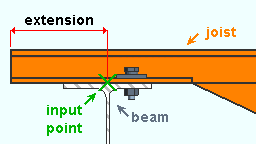
Even if the joist slopes, this dimension is measured horizontally. '
Field clearance ' may be entered by a user when "
Auto " is off (unchecked).
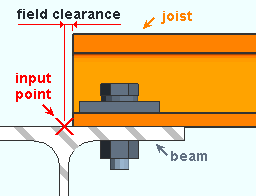
For a joist to beam ' Bearing connection , the field clearance is the distance parallel with the workline of the joist (in the primary dimension " Units " or other units ) from the input point of the joist ( X ) to the top of the joist's top chord. This distance is measured along the top of the joist's top chord.
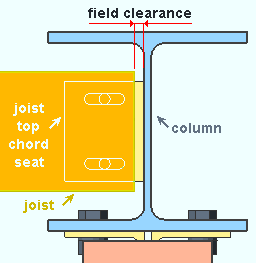
For a joist seat, the field clearance is the distance parallel with the workline of the joist (in the primary dimension " Units " or other units ) from the top edge of the joist's top chord to the face of the supporting member. '
Setback ' may be selected for " Top chord " when "
Auto " is off (not checked).
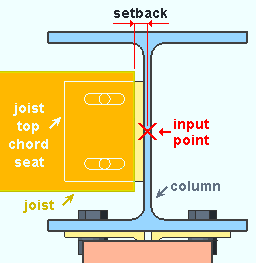
The setback is the horizontal distance (in the primary dimension " Units " or other units ) from the input point to the edge of the joist. For a seated connection, the field clearance and setback are different dimensions.
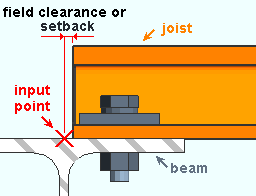
For a horizontal joist bearing on a web vertical beam's top flange, the setback is equal to the field clearance.
Shoe: ' ![]() Auto or
Auto or ![]() Extension or
Extension or ![]() Field clearance or
Field clearance or ![]() Setback . These dimensions position the top chord left- or right-end shoe. They require the entry of a positive distance from the input point. '
Setback . These dimensions position the top chord left- or right-end shoe. They require the entry of a positive distance from the input point. ' ![]() Extension ' and '
Extension ' and ' ![]() Setback ' are horizontal dimensions. '
Setback ' are horizontal dimensions. ' ![]() Field clearance ' is measured parallel with the slope of the joist.
Field clearance ' is measured parallel with the slope of the joist.
'
Auto (checked) ' indicates that the program has been instructed to automatically apply a field clearance. Turning auto off ("
Auto " ) lets a user in a full-featured SDS2 program enter a different field clearance or an " Extension ' distance or etc.
'
Extension ' may be entered by a user when "
Auto " is off (unchecked). and a choice other than ''Full (R type) extension is selected for " Top chord '.
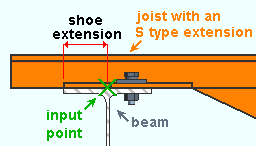
Even if the joist slopes, this dimension is measured horizontally. A " Shoe " extension can optionally be applied to a ' Chord only (S type) extension '. '
Field clearance ' may be entered by a user when "
Auto " is off (unchecked).

For a joist to beam ' Bearing connection, the shoe field clearance is the distance parallel with the workline of the joist (in the primary dimension " Units " or other units ) from the input point of the joist ( X ) to the edge of the shoe. .
For a joist seat (not shown), the shoe field clearance is the distance parallel with the workline of the joist (in the primary dimension " Units " or other units ) from the edge of the shoe to the face of the supporting member. '
Setback ' may be entered by a user when "
Auto " is off (unchecked).
Bottom chord : ' ![]() Auto or
Auto or ![]() Extension or
Extension or ![]() Field clearance or
Field clearance or ![]() Setback . All of these dimensions require the entry of a positive distance from the input point. '
Setback . All of these dimensions require the entry of a positive distance from the input point. ' ![]() Extension ' and '
Extension ' and ' ![]() Setback ' are horizontal dimensions. '
Setback ' are horizontal dimensions. ' ![]() Field clearance ' is measured parallel with the slope of the joist.
Field clearance ' is measured parallel with the slope of the joist.
|
'
Auto ' indicates that the program has been instructed to automatically apply a field clearance when "
Extend bottom chord " is checked. When "
Extend bottom chord " is turned off, an auto setback is applied. Turning auto off ("
Auto " ) lets a user in a full-featured SDS2 program enter a different field clearance or an " Extension ' distance or a ' Setback '.
An '
Extension ' distance may have been entered by a user in a full-featured SDS2 program when "
Auto " is off (unchecked). It works much the same as when '
Full (R type) extension ' is selected for the " Top chord ," but applies to the bottom chord.
A '
Field clearance ' distance may have been entered by a user in a full-featured SDS2 program when "
Auto " is off (unchecked). It works much the same was as when '
Field clearance ' is selected for the " Top chord ," but applies to the bottom chord.
A '
Setback ' distance may have been entered by a user in a full-featured SDS2 program when "
Auto " is off (unchecked). This works just like selecting '
Setback ' for the " Top chord ," except that this applies to the bottom chord.
page 1 | contents | review | top
|
|
|||||||||||
|
|
||||||||||
Load (kips or kN): The load on this end of the joist in kips (kilonewtons for ' Metric '). The loads for each end of a joist must be entered for a full-featured SDS2 program to do the proper calculations.
Note: AISC requires a minimum of 6 kips for all connections (10 kips for LRFD )."
page 1 | contents | review | top
|
|
|||||||||||||
|
|
||||||||||||
A left- and right-end " ![]() Summary " can be shown on this window only if you are editing one joist. There is no summary if you are editing multiple joists.
Summary " can be shown on this window only if you are editing one joist. There is no summary if you are editing multiple joists.
The "
Summary " gives you connection information related to the left or right end of the joist.
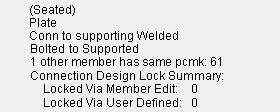
The summary shows (in parentheses) the " System designed connection " on that end of the joist.
If other joists have been assigned the same piecemark as this joist, the summary will list those other joists by member number .
"
Connection design locks " that were locked (
) because the " Input connection type " is ' User defined ' are reported as " Locked Via User Defined ." All other locks that are locked (
) are reported as " Locked Via Member Edit ."
page 1 | contents | review | top
|
|
|||||||||||
|
|
||||||||||
Locked (
) connection design locks are entries made by users of a full-featured SDS2 program .
Unlocked (
) connection design locks are computer-generated values entered by connection design . In many cases, connection design populates the unlocked fields based on user-entered setup choices.
These same connection design locks may also be found on the Connection Component Edit window for this connection.
When checked, "
Show images " displays drawings that depict the dimensions associated with connection design locks.
Connection design locks are grouped togetner under leaves with the following names:
|
|||||||||
page 1 | contents | review | top
|
|
|||||||||
|
|
||||||||
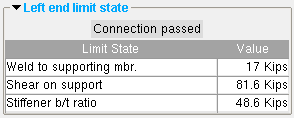
|
The limit states for a seated plate connection on the left end of a joist. In this example, the connection passes. |
A limit state is a potential connection failure mode.
The capacity of a connection is calculated for various limit states during connection design . Each " Value " reported in the example above represents the strength of the connection or of the joist itself or of its supporting member with respect to a particular limit state.
Since connection design takes place in a full-featured SDS2 program , but not in SDS2 Site Planning, the limit states that are reported on this review-only window are static and cannot be changed.
If connection design in a full-featured program has determined that the capacity of a connection is insufficient to stand up to the "
Loads " on a member, the program will have failed the connection and generated a connection failure message.
The Design Calculations Report together with the Connection Calculation Cover Sheet (or the Expanded Connection Design Calculations as a stand-alone report) provide formulas and the results of calculations (or the actual calculations) that relate limit states to the design of the specific connection.
page 1 | contents | review | top
"Properties" opens the Edit Properties window, on which you can make entries to custom properties . If, at the time it was created, your current Job was set to use a legacy flavor, the window that opens is named Custom Properties , not Edit Properties .
The Edit Properties window can also be used to read "
Log " entries or review or type "
Notes ."
Tip: Model > Member > Properties is an alternative to this button. It opens the Edit Properties window directly, without your first having to open a member review window.
" Status " opens the Member Status Review window for the joist(s) that you are reviewing. You can use that window to update status information about the joist(s).
" OK " (or the Enter key) closes the Joist Review window (this window) and saves to the member file(s) any changes made on the Member Status Review window.
Change all: If you double-clicked a joist and made a change to its status and the 3D model contains other joists with the same piecemark as this joist, a yes-no dialog opens after you press " OK ." On that yes-no dialog is the question, " Do you want to change all .... " Press the " Yes " button to update the status of all the joists with this piecemark; press the " No " button to change only this one joist.
Tip: The yes-no "change all" dialog tells you the count of the members with this " Piecemark ." Another way to find out the count of members under the piecemark is to look under the "
Summary " on this window.
" Cancel " (or the Esc key) closes this window without saving any status changes made on the Member Status Review window.
" Reset " undoes all status changes you made to this member on the Member Status Review window.
"Design Calc" outputs a report that includes this joist's connection design calculations, general settings and left/right end settings. If you are reviewing multiple joists with the same piecemark (or different piecemarks), you get a report for each joist. Each report is output to the destination specified at User and Site Options > Output > " Reports ."

Tip: To get a report listing similar specifications for multiple members, output a Check Report and a Design Calculations Report .
"Expanded Calc" outputs the Expanded Connection Design Calculations . Output is to your web browser.
Expanded Connection Design Calculations is a report that provides all of the information in the Connection Design Calculations combined with related information from the Connection Calculation Cover Sheet . In addition, the report shows you the calculations written out, in detail, in the report itself, instead of simply reporting the results. Certain browser requirements must be met in order for you to access this report.
If you are reviewing multiple joists with the same piecemark (or different piecemarks), you get a report for each joist.
Connection design failures can be found with the aid of a search or by a quick scan of the document. Calculations that result in a connection failure are identified as " (NO GOOD) " in their concluding line. You might also search for the string "CONNECTION DESIGN FAILURE".